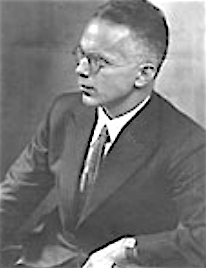
Eugen Carl Kaufmann [also known as Eugene Charles Kent] was born in Frankfurt am Main, Germany, on 8 January 1892 and studied at the Technischen Hochschule in Berlin from 1910 to 1912 and the Technischen Hochschule in Berlin in Munich from 1912 to 1914. During these years, he gained work experience in the offices of Hermann Muthesius and Oskar Kaufmann. After serving in the Army in World War One, he began practising as an architect. Between 1919 and 1922 he worked for Oscar Wolff in Halle-am-Saale, mainly designing shops for a chocolate manufacturer. During this period he also won first prize in a competition to design a Völkshaus in Halle-am-Saale. He then briefly worked in the Magdeburg City Planning Office under Bruno Taut from 1922 to c.1924.
In 1925 Ernst May, the newly appointed head of the City Planning Department in Frankfurt-am-Main, invited Kaufmann to join the department where he subsequently played a prominent role supervising some 60 drawing offices and designing schools. In 1930, with Franz Kade, he published Die neue Dorfschule.
About this time he became a member of Der Ring, an influential architectural collective founded in Berlin in 1926, and was involved in the Congrès Internationaux d'Architecture Moderne (CIAM) and supervised the exhibition Die Wohnung für das Existenzminimum held as part of the 2nd CIAM Congress in Frankfurt in 1929. Kaufmann also participated in the 3rd CIAM Congress in Brussels in 1930 and the 5th CIAM Congress in Paris in 1937.
From 1931 to 1933 he worked as an architect in Kharkhov and Moscow, USSR. In 1933 his contract expired. By this time, the National Socialists had come to power in Germany, and as he was Jewish, Kaufmann decided that it would not be safe to return to Berlin. He, therefore, emigrated with his family to England in summer 1933.
A year after his arrival in London he formed an architectural partnership with Frederick Edward Towndrow (1897-?). Subsequent projects by Towndrow & Kaufmann included housing in Wimbledon, Angmering-on-Sea and Gerrards Cross; shops and commercial premises for Moss Bros., Rothmans and others; and extensions to schools in Hampstead and, with Godfrey Samuel, Otterden, Kent. A house in Wimbledon designed by Kaufmann in collaboration with Elisabeth Benjamin (1908-1999) is discussed in The Modern House in England by F.R.S. Yorke (London: The Architectural Press, 1947 pp. 40-41).
Kaufmann was also for a period Director of Research for the Housing Centre. Following the outbreak of World War Two in 1939, Kaufmann's partnership with Towndrow was dissolved.
During the war, Kaufmann worked for Herefordshire County Council on temporary housing schemes for evacuees from London. Following the war, he resumed private practice in London. He retired in 1967 and died in London, England, on 21 June 1984.
Benton, Charlotte. A different world: emigre architects in Britain 1928-1958. London: Heinz Gallery, 1995
‘Small house, Welwyn, in brick’ [Architect: E. C. Kaufmann] Architects’ Journal 28 December 1939 p.762
Thirties: British Art and Design before the War. London: Arts Council of Great Britain, 1979 [Catalogue of an exhibition at the Hayward Gallery, London, 25 October-13 January 1979]